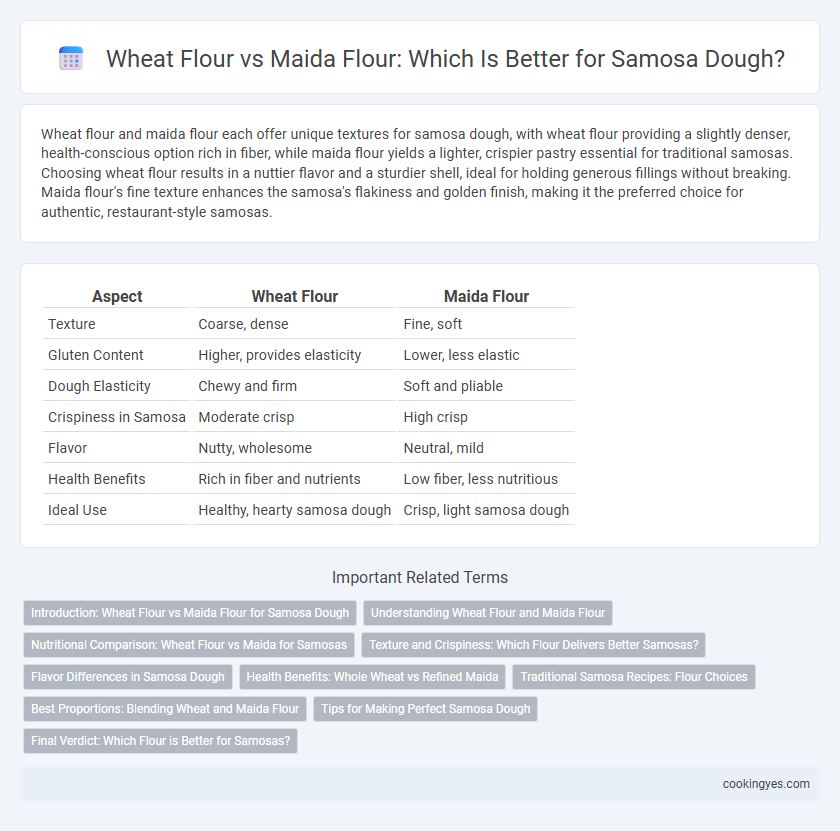Wheat flour and maida flour each offer unique textures for samosa dough, with wheat flour providing a slightly denser, health-conscious option rich in fiber, while maida flour yields a lighter, crispier pastry essential for traditional samosas. Choosing wheat flour results in a nuttier flavor and a sturdier shell, ideal for holding generous fillings without breaking. Maida flour's fine texture enhances the samosa's flakiness and golden finish, making it the preferred choice for authentic, restaurant-style samosas.
Table of Comparison
| Aspect | Wheat Flour | Maida Flour |
|---|---|---|
| Texture | Coarse, dense | Fine, soft |
| Gluten Content | Higher, provides elasticity | Lower, less elastic |
| Dough Elasticity | Chewy and firm | Soft and pliable |
| Crispiness in Samosa | Moderate crisp | High crisp |
| Flavor | Nutty, wholesome | Neutral, mild |
| Health Benefits | Rich in fiber and nutrients | Low fiber, less nutritious |
| Ideal Use | Healthy, hearty samosa dough | Crisp, light samosa dough |
Introduction: Wheat Flour vs Maida Flour for Samosa Dough
Wheat flour and maida flour are the two primary options for making samosa dough, each affecting texture and taste differently. Wheat flour offers a coarser texture and higher fiber content, resulting in a healthier, crunchier samosa shell. Maida flour, a refined version of wheat, creates a softer, lighter dough that yields a crispier and more delicate samosa crust favored in traditional recipes.
Understanding Wheat Flour and Maida Flour
Wheat flour, made from whole wheat grains, contains bran and germ, providing more fiber and nutrients compared to maida flour, which is refined and bleached, resulting in a finer, smoother texture ideal for crispy samosa dough. Maida flour has higher gluten content than whole wheat flour, contributing to a lighter, flakier pastry shell preferred in traditional samosas. Choosing between wheat flour and maida flour affects the dough's elasticity, crispness, and overall taste, making maida more popular for classic samosa recipes while wheat flour offers a healthier alternative with a denser texture.
Nutritional Comparison: Wheat Flour vs Maida for Samosas
Wheat flour contains higher fiber and essential nutrients like iron, B vitamins, and protein compared to maida, making it a healthier option for samosa dough. Maida, or refined flour, undergoes extensive processing that strips away bran and germ, resulting in lower fiber content and increased glycemic index. Choosing wheat flour can enhance the samosa's nutritional profile by providing better digestion support and sustained energy release.
Texture and Crispiness: Which Flour Delivers Better Samosas?
Wheat flour produces samosa dough with a slightly coarser texture, resulting in a rustic and hearty bite, while maida flour offers a finer, smoother dough that crisps up more evenly and delivers a lighter, flakier samosa shell. The higher gluten content in wheat flour provides more elasticity but can yield a denser crust, whereas maida's refined starch creates superior crispiness and delicate layering when fried. For samosas prioritizing crispiness and a tender, melt-in-the-mouth texture, maida flour is the preferred choice, whereas wheat flour suits those seeking a more robust and wholesome texture.
Flavor Differences in Samosa Dough
Wheat flour imparts a nuttier, earthier flavor to samosa dough, enhancing the overall taste with a subtle grainy richness. Maida flour, being more refined and neutral in taste, produces a lighter, crispier texture but offers a less complex flavor profile. Choosing wheat flour results in a heartier samosa with deeper flavor nuances, whereas maida flour emphasizes crispness over flavor intensity.
Health Benefits: Whole Wheat vs Refined Maida
Whole wheat flour offers more fiber, vitamins, and minerals compared to refined maida, which is stripped of nutrients during processing. Using whole wheat flour for samosa dough enhances digestion, promotes better blood sugar control, and supports heart health due to its lower glycemic index. Maida flour, while providing a softer texture, lacks essential nutrients and may contribute to weight gain and increased risk of chronic diseases when consumed excessively.
Traditional Samosa Recipes: Flour Choices
Traditional samosa recipes predominantly use maida flour for its fine texture, resulting in a crisp and flaky outer shell that enhances the overall taste experience. Wheat flour, being coarser and richer in fiber, produces a denser samosa crust that is slightly nutty but less crispy compared to maida-based dough. The choice between wheat and maida flour significantly impacts the samosa's texture, flavor, and nutritional profile, with maida favored for authenticity and crispness, while wheat flour offers a healthier, whole-grain alternative.
Best Proportions: Blending Wheat and Maida Flour
Blending wheat flour and maida flour in a ratio of 2:1 creates the ideal samosa dough, combining the fiber-rich texture of wheat with the crispiness of refined maida. This balance enhances dough elasticity while ensuring a flaky, crunchy crust that holds fillings without breaking. Using 66% wheat flour and 33% maida flour optimizes taste, texture, and nutritional value in traditional samosas.
Tips for Making Perfect Samosa Dough
Using wheat flour for samosa dough results in a healthier, slightly coarser texture with added fiber, while maida flour creates a crispier, lighter crust. To achieve perfect samosa dough, mix flour with a pinch of salt, use cold water gradually to avoid stickiness, and incorporate oil or ghee for enhanced flakiness. Resting the dough for at least 30 minutes improves elasticity, ensuring easy rolling and a delicate, crunchy samosa shell.
Final Verdict: Which Flour is Better for Samosas?
Wheat flour and maida flour differ significantly in texture and nutritional content, impacting samosa dough quality. Maida flour produces a crispier, flakier crust ideal for traditional samosas, while wheat flour offers a healthier, fiber-rich alternative with a denser, chewier texture. For authentic samosas, maida flour is preferred for its superior crunch and ease of rolling, but wheat flour suits health-conscious consumers seeking a nutritious option.
Wheat Flour vs Maida Flour for samosa dough Infographic

 cookingyes.com
cookingyes.com